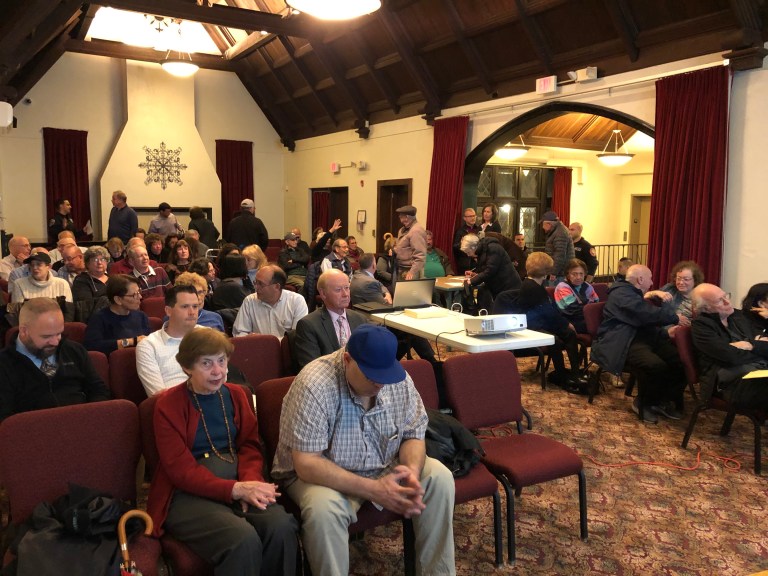
Nassau County Department of Public Works officials found that intersections off of Middle Neck Road see more crashes per million vehicles than the statewide average after a traffic study of the road was conducted earlier this year.
The study was done over several months by the public works department and L.K. McLean Associates.
The results, presented to a group of more than 50 community members on Thursday, confirmed many of the concerns that local officials and residents have recently raised.
“There were many goals and objectives of this study that took place,” L.K. McLean’s President and CEO Raymond DiBiase said. “The overall goal is to find solutions that can help both the drivers and pedestrians in the area.”
The team at L.K. McLean Associates is no stranger to roads in the Great Neck Area. In 2003, they conducted a study on Great Neck Road and presented traffic calming initiatives.
The study for Middle Neck Road stretched approximately 2.32 miles running from the northern point of Redbrook Road down to the southern limit of Darley Road and Susquehanna Avenue.
Some 36 intersections were incorporated, 22 of which were intersections with traffic lights. The villages of Great Neck, Great Neck Estates, Great Neck Plaza, Thomaston, Russell Gardens, and Kensington were all included in the studied area.
The area was broken up into four sectors, where speed, crash, pedestrian, and traffic flow analysis were all conducted.
“These studies were conducted this year, not too many months ago,” Nassau County Legislator Ellen Birnbaum (D-Great Neck) said. “This affected area is where our residents have found the most amount of issues for driving and walking.”
Intersections were given a level of service grade to determine how delayed each one is. Aside from an additional “E” grade, the format follows the typical A-F grading system of passing and failing.
A vehicle being delayed 10 seconds or less qualifies the intersection for an “A” grade, while anything 80 seconds or over results in an “F” grade.
Studies from the morning, afternoon, and nightly weekday peak driving periods showed that the average delay time from the intersection of Barstow Road and Schenck Avenue was 59.82 seconds. That time warrants an “E” grade, meaning progression is poor, and the frequency of stopped vehicles is high.
The Barstow and Schenck intersection was highlighted as one of the “more troublesome and delayed” ones, according to DiBiase.
Three main intersections were also highlighted as the prominent vehicular crash sites over the past four years.
The intersection of South Station Plaza and Great Neck Road has seen 123 crashes in four years, exceeding the statewide rate of 2.42 crashes per million entering vehicles, according to the study.
The three intersections, which also include Middle Neck Road and Grace Avenue, and North Station Plaza and Cutter Mill Road, have seen a combined 248 crashes in the past four years. All three have at least a 19 percent crash rate as a result of drivers overtaking lanes.
Combined, at just those three intersections, there have been 25 pedestrian crashes, none of which resulted in any fatalities.
Residents urged local officials and the public works department to make necessary adjustments to prevent pedestrian accidents, without an inconvenience to the drivers.
“I understand that we don’t want to inconvenience drivers,” one resident said. “But when it comes to pedestrian safety, I think that has to be the main priority here. People can wait a few extra seconds at a traffic light if it means someone a bit older can get across the street.”
Village of Great Neck Plaza Mayor Jean Celender said she is aware of these issues and has been working with the county to address some of the measures needed to be taken to ensure all-around safety.
Great Neck resident Jean Pierce, who has expressed her frustrations with drivers during Village of Great Neck board of trustees meetings before, implored members of the public works department to physically walk alongside and across the studied intersections to see “just how dangerous they really are”.
DiBiase said that the next steps for the department and the project, are to incorporate public input provided at the meeting, and for the next few weeks, defining potential traffic calming improvements, and finalize recommendations on what should be done.
He also said there will be a second public information meeting, which local municipalities will be notified about “significantly in advance”.







My observations over the past decade have been that fellow drivers tend to be 1) impatient of others driving closer to the speed limit, 2) strangely competitive with other drivers especially at stop lights, 3) often rolling through stop signs, and 4) intolerant of people and bicycles on the road. I have noticed this on the main roads such as Middle Neck Road, West Shore / Bayview Avenue, East Shore Road. My suggestion is utilize a single lane as they do on Plandome Road all the way from Northern Blvd to the top of the Peninsula. Install additional traffic lights and stop signs after the conversion to a single lane stretch. Larger shoulders for bicycle riders and worshipers. Eliminate parking around crosswalks that do not have a traffic control device. Eliminate any opportunities where the road will open up to two lanes. This will calm traffic, maintain speed limit, make upper Great Neck more pedestrian / bike friendly, increase visibility for drivers, and remove all opportunity for competitiveness. Let’s act quickly and not drag this out like many things often do.